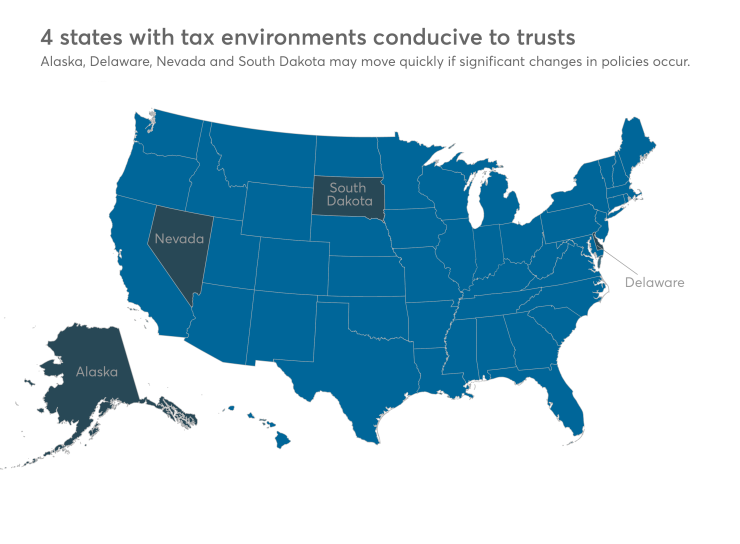Advisers may be wondering how they can guide clients on estate planning when the country is still awaiting potentially significant changes to U.S. tax policy from President Donald Trump. Should they wait to discuss such planning with clients until there is a more-definitive policy?
The answer to that is a resounding no. A large component of estate planning, for one, involves transferring assets to irrevocable trusts. This offers a number of non-tax-related benefits, including asset protection, divorce protection and management structure for potential future disability.
There is no point in waiting on new tax laws to implement planning that is protective and vital no matter what the ultimate platform may be. Clients need advisers to help them focus on the importance of planning for their futures, instead of being transfixed by the ever-evolving tax debate in Washington.

It may actually be better to go forward with tax planning before changes in policy are made, anyhow.
And it may actually be better to go forward with tax planning before changes in policy are made, anyhow. For one, many tax commentators do not believe that estate tax repeal will come without a sunset provision (e.g., in 10 years the taxes will come back into force). Or, even if it does, a future administration may still reinstate them.
If President Trump repeals the generation-skipping transfer tax, it may be impossible to thereafter shift assets outside of the transfer tax system, as there may be no tax system to shift out of. That might leave clients unable to move assets permanently outside the tax system (“GST exempt” in current jargon) until the estate tax rules are reinstated at some future date.
PLAN TODAY, NOT TOMORROW
If you can succeed in convincing clients to plan today instead of in a potentially more uncertain or challenging tomorrow, what should they do differently in using trusts now?
Here’s a checklist of ideas to put on the planning table with your clients:
- Flexibility is the key. Clients should use trusts that are flexible given the uncertainties and variability in what may occur with the tax laws.

- Consider trust-friendly jurisdictions instead of the client’s home state. Four states in particular — Alaska, Delaware, Nevada and South Dakota — appear to have led the charge for creating tax and legal environments that are conducive to trusts. This is important now, because if significant changes in policy occur, these states may react quickly with new laws. Many other states might not follow for a decade or longer.
- Use trust protectors. A protector is generally an independent person (not a beneficiary or trustee) who acts in a fiduciary capacity and is given powers to remove and replace the trustee, change the situs (where the trust is administered) and governing law of the trust, and wield other powers. This position is relatively new in terms of U.S. trust planning, but it is a great means of adding additional flexibility to an estate plan.
- Be certain the client may benefit from the trust assets. Unless there is a personal, legal or tax reason otherwise, make a spouse the beneficiary, so the client can indirectly benefit through the spouse receiving distributions from the trust. Even if the client is not currently married, the trust can add the right of a future spouse to be a beneficiary. In some circumstances, a floating spouse can be added – whomever the client is married to at any time will be a beneficiary.
- For single clients, or clients who are worried about only being able to access trust assets through a spouse, create a domestic asset protection trust. This is a trust, formed in one of the 17 states that permit them, in which the assets are outside the client’s estate but the client can nonetheless remain a beneficiary. If the adviser team is too concerned about the risks of a DAPT, use a hybrid DAPT. This is a trust formed in one of those same states that does not immediately list the client as a beneficiary of her own trust but which instead gives a person, acting in a non-fiduciary capacity, the power to add any descendant of the client’s grandparents as a beneficiary.
- Consider a loan provision that gives a person, not acting as a fiduciary, the right to loan trust assets to the client who created the trust. While adequate interest should be charged, adequate security for the loan should not be required. This is a power that has been used historically to make a trust a grantor trust (taxable to the client/grantor). In recent years, this power has fallen into disuse as swap power (the right to swap assets outside the trust for assets in the trust of equivalent value) became the default technique to create grantor trust status. The loan provision, however, can be added not because it is needed to create grantor trust status, but to provide another way for a client to access trust assets without making them reachable by creditors or causing estate tax inclusion.
- Most or all trusts should be set up to be grantor trusts. This means that trust income is taxable to the grantor. The most common provision used to achieve this status is the swap power noted above. Under current law, this power can permit the client/settlor to swap assets from her personal name into the trust, in exchange for assets of equivalent value. This can be used to pull highly appreciated assets out of an irrevocable trust so they are included in the client’s estate on death, and can achieve a step-up or increase in income tax basis. This means the basis on which capital gains is calculated is reset to fair value, thus eliminating capital gains on a later sale. If the Trump administration enacts a capital gains on death tax, this same swap power may be used in reverse to swap appreciated assets from a client’s estate, where they would be subject to a capital gains tax on death, into an irrevocable trust, where they might avoid that gain. This flexibility is another reason to plan now and not wait.
The tax law is uncertain, but estate planning should proceed as always. And if that planning is done with creativity and flexibility, clients should benefit no matter what the final tax policy may be.





